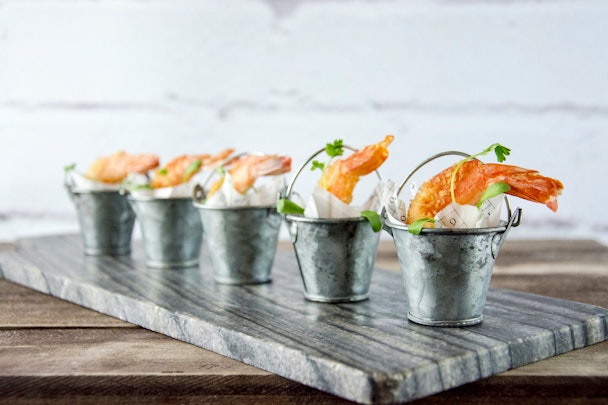B2B events hospitality: A secret frontier for new food and drink trends?
For The Drum’s food & drink focus week, Chloe Ward of Wonder (part of the Amplify group) argues that B2B events are becoming an increasingly relevant testbed for dining innovation.

Are B2B events becoming a hotbed of food & drink innovation / Alice Pasqual via Unsplash
In the dynamic arena of event food & drink, where culinary innovation takes center stage, gone are the days of the humble chocolate fountain (thankfully, given their questionable oil content). Today’s edible entertainment demands a multisensory journey that not only looks amazing for that shareable Insta snap, but also surprises the taste buds with new flavor combinations and immersive storytelling.
Events have always been hubs for pushing the boundaries and trying something new. With a captive audience, usually of a decent size, these occasions become ideal platforms for culinary experimentation, allowing for the exploration of emerging food trends and the trial of unique serving methods.
Advertisement
Give ‘em what they (really) want
Food stands as an unsung hero in the realm of business experiences.
In contrast to B2C events, in these business environments, food is as much about providing a crucial function as it is a creative experiential showcase. Whether it’s the coffee that gets you on to a stand at a busy trade show, or the sit-down dinner that bookends a long day of formal meetings, food and drink have to satisfy the needs and wants of business audiences.
But meeting audience expectations means understanding their evolving tastes.
Although food needs to be one of the most palatable of all event elements (you’re not there to feel challenged by the cuisine), there’s been a noticeable shift over the past few years to more holistically inclusive choices, with brands keen to demonstrate an ethical standpoint. With 13% of Brits now classing themselves as ‘flexitarians’, the door is open for more progressive culinary consideration.
Plant-based options, non-alcoholic drinks, and zero-waste catering logistics: the choices brands make about food - and food waste - are key signifiers of how they operate as businesses: responsible, altruistic or economical.
Advertisement
Breaking out of the (lunch) box
With business experiences breaking out of the B2Boring stereotype, food doesn’t have to fade into the background.
Brands are recognizing the power of a well-curated menu as a tool for storytelling. The right combination of flavors, presentation, and thematic alignment can turn a meal into a memorable set piece that reinforces brand identity and resonates with attendees long after the event concludes.
For example, we paired the Michelin-starred Tom Kitchin with Korea’s legendary Chef Mun to curate a menu for the Genesis Scottish Open that demonstrated the subtle, complementary blend of Scottish and Korean cultures at the event. The chefs also held Q&As and tastings for the hospitality guests.
Having personalities like this present at the event to mingle with guests can hold as much star power as a headline DJ. And as the allure of event catering gains notoriety and recognition, more chefs are seizing the opportunity to showcase their culinary prowess through innovative pop-up offerings.
Suggested newsletters for you
Cuisine as cultural connector
Taking inspiration from TikTok’s ‘oddly satisfying’ content trends, tricks like cold plate ice cream crafting have provided event audiences with shareable set pieces. These moments have visual appeal and offer sensory experiences, acting as a fun stand attractor and doubling as a tasty gift.
Meanwhile, the rise of themed cooking TV shows like The Great British Menu signifies a growing trend in immersive and sensory-led culinary experiences. These shows fuse food, music, scent, props and interactivity to craft a captivating multi-sensory showcase that also tells a story. With dishes inspired by the Olympics and Paralympics, this culinary creativity prompts excitement for what will be showcased at the Games later this year: a great example of how blending a theme with immersive gastronomy can showcase more engaging and dynamic food design in mainstream entertainment.
The popularity of immersive dining experiences further amplifies this shift. Not content with just an immersive theater experience, people are now looking for incredible food to elevate all the senses. Take The Monarch Theatre experience at Park Row, a private room for twenty offering a multi-sensory dining experience inspired by heroes and villains of the DC Comics universe. With some seriously impressive floor-to-ceiling 360-degree projection mapping and a narrator to guide you through the story, the food and drink blends creativity and culinary artistry to engage taste, sight, sound, touch, and aroma. These experiences are redefining the dining and hospitality landscape, adding a new dimension to the evolving tastes of business audiences.
Most importantly, food and drink support natural moments of togetherness for attendees at business experiences - the right menu choices help engineer elevated connections via the most basic human needs. A seamless, enjoyable facilitator of memorable moments together - dining is unquestionably the meat and drink of business experiences.
For more about food, drink, and the smartest ways to market them, check out our dedicated focus week hub.
Content by The Drum Network member:

Amplify
We solve problems.
At the heart of any problem is a person. A real person. What they think, believe, want or need. We help brands to connect with them and...

